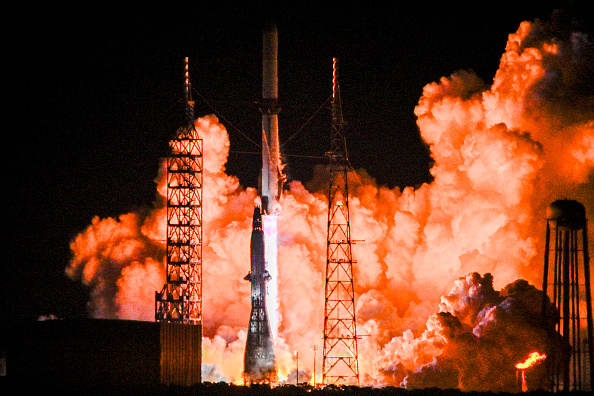Blue Origin launched its towering New Glenn rocket for the first time on Thursday, in a crucial milestone for Jeff Bezos’ space company.
New Glenn thundered off the launchpad in the early morning hours in Florida, reaching space and ultimately making it to orbit as a part of a long-awaited debut mission. Blue Origin also attempted to land the rocket’s booster on a barge in the Atlantic Ocean, but the booster was lost during reentry through the atmosphere.
The launch is a defining moment for Blue Origin.
Although founded 25 years ago, Bezos’ company had yet to begin flying to orbit — with its much smaller New Shepard rocket only flying people and research on short jaunts to the edge of space. New Glenn’s flight marks Blue Origin’s entrance into a market dominated by Elon Musk’s SpaceX and is crucial to unlocking the centi-billionaire founder’s larger ambitions.
No one was on board the New Glenn flight, which carried a single small test payload into space. The rocket was named to honor the late John Glenn, the first American to orbit the Earth.
Originally the company was aiming for the audacious feat of flying NASA’s “ESCAPADE”mission to Mars on New Glenn’s debut. But with a dwindling launch window, the agency delayed ESCAPADE to a later launch. Blue Origin also has orders from Amazon
Headquartered in the Seattle suburb of Kent, Washington, Blue Origin has over 10,000 employees there and in half a dozen other major locations around the country, including in industry strongholds of Texas, Florida and Alabama. Blue Origin CEO Dave Limp previously told CNBC that Blue Origin has been “in kind of an R&D phase for a long time,” an aspect of the company’s culture he’s trying to change.
Blue plans to scale the cadence of New Glenn missions quickly, wanting to perform as many as 10 New Glenn launches this year. Originally targeted for a 2020 debut, the rocket faced years of delays.
The mission
A few minutes after launch, the rocket’s booster separated and returned back through the atmosphere. The booster — nicknamed “So You’re Telling Me There’s a Chance” — was attempting to land on the company’s barge Jacklyn about 600 miles offshore in the Atlantic Ocean, but fell short. Blue Origin’s webcast last showed the booster at an altitude of about 84,000 feet.
While New Glenn did not deploy any satellites in orbit on the flight, it carried a small demonstration version of the company’s “Blue Ring” spacecraft. Known in the industry as an orbital transfer vehicle (OTV), or space tug, Blue Ring is designed to host satellites and spacecraft, delivering them from the rocket to their intended target.
As is typical with an orbital rocket’s debut, New Glenn’s launch had some bumps along the way, with multiple day delays due to technical issues with the rocket and weather.
The rocket
New Glenn is the size of a 30-story skyscraper at 322 feet tall, nearly as tall as the Saturn V rockets that carried the Apollo missions to the moon, and 23 feet in diameter. Blue’s rocket is powered by seven of the company’s BE-4 engines, together generating nearly 4 million pounds of thrust, and the nosecone of New Glenn is both wide and tall enough to launch three school buses into space at once.
The rocket is powered by liquid oxygen and liquid methane and is designed to be partially reusable, as Blue Origin aims to launch, land and re-launch each booster as many as 25 times.
In terms of mass delivered to orbit per launch, New Glenn fits between SpaceX’s Falcon 9 and Falcon Heavy rockets, with Blue Origin’s vehicle designed to lift as much as 45,000 kilograms (or about 100,000 pounds) to low Earth orbit.
Blue Origin has not disclosed the total cost or pricing per launch of its New Glenn rockets. Three years ago, Blue Origin said it had invested $2.5 billion to date on New Glenn development. And, according to a competitor’s estimate, New Glenn sells for about $70 million per launch.
So far in the industry table stakes of orbital missions, Blue Origin had not entered the serious rocketry game, as the U.S. launch market remains dominated by SpaceX, followed by Rocket Lab
Already, Blue Origin has a foothold with New Glenn in the most lucrative part of the launch market: Flying for the military. Last year Blue Origin joined SpaceX and ULA in the Pentagon’s $5.6 billion National Security Space Launch (NSSL) program, allowing the company to compete for contracts.
While Blue Origin has lagged SpaceX in the industry, Bezos has remained upbeat about his company’s potential.
“I think it’s going to be the best business that I’ve ever been involved in, but it’s going to take a while,” Bezos said recently.
Jeff, welcome to the club.
International: Top News And Analysis
Read the full article <a href="Read More” target=”_blank”>here.


